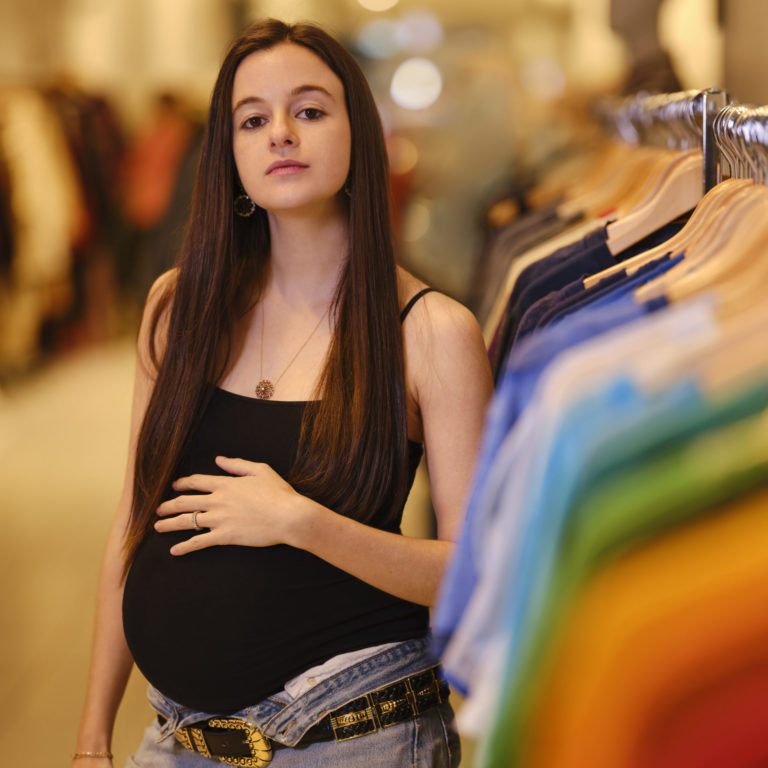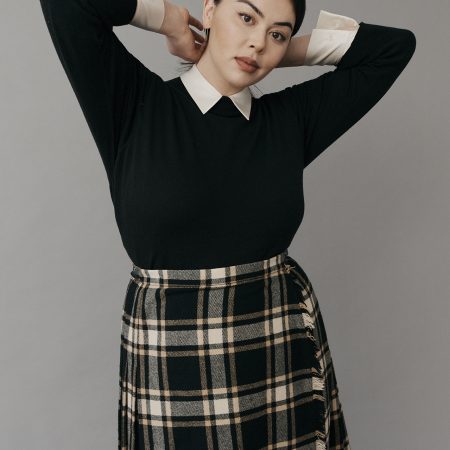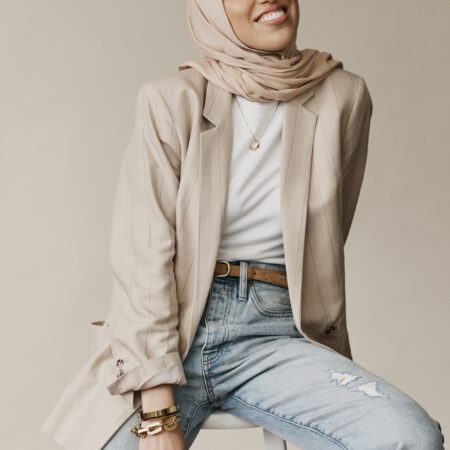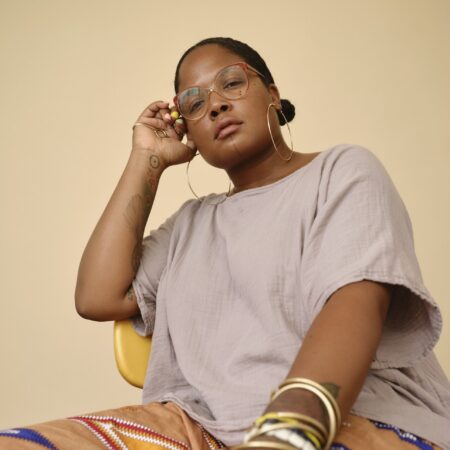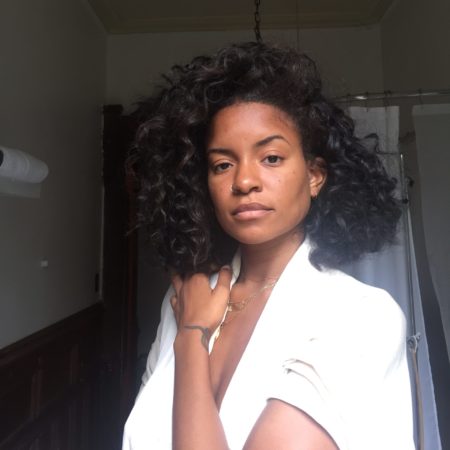Ten years ago, Samantha and Morgan Elias started what would soon become one of New York’s largest vintage fashion brands out of their mom’s basement in Long Island. The sister duo took their business idea of reworked and hand-picked vintage pieces from their college dorm to their own standalone stores in prime SoHo and Nolita locations. Years ahead of the fashion industry’s sustainability movement and unlike today’s buzzy mega brands, The Vintage Twin wasn’t built on venture capital funding or aesthetically-pleasing millennial branding. Instead, the twins focused on making shopping vintage fashion less overwhelming—from personal styling services to a Jeanius Bar that became the cool girl’s go-to for vintage denim. But now, with the forced closure of all non-essential businesses, COVID-19 is threatening that decade of blood, sweat, and tears.
Like many small business owners at the beginning of the coronavirus pandemic, Samantha and Morgan dreamed of voluntarily closing their doors while continuing to pay their employees, but with 90 percent of their revenue coming from brick-and-mortar, they ultimately realized they couldn’t afford that luxury. In the end it didn’t matter, because days later they would be forced to close, laying off close to 30 employees. As many family-run and self-funded brands struggle through these uncertain times, we sat down with Samantha Elias to learn how she and her sister were able to build their company entirely on their own—and how they’re now fighting to keep it alive.
How did the idea for The Vintage Twin come to be?
I went to the University of Michigan about 10 years ago to study business and sustainability. When I got there, I made some non Tri-State friends and discovered vintage. I started wearing it exclusively and when I came to New York City that summer, I was stopped 10 times a day, no exaggeration. It was too much attention to ignore. So my twin sister and I did a vintage T-shirt sale in my mom’s basement. I made a Facebook event, the driveway filled up with Long Island girls and it did great, we called it The Vintage Twin.
We took the inventory back to school and I started selling straight out of my dorm room. All along, we were selling to what I endearingly call your “basic bitch” consumer. We were not selling to urban dwelling, cool city kids. They were there almost in spite of the fact that it was vintage—they were there because it was The Vintage Twin. That’s how we really came to develop our thesis around how a brand can fundamentally change the [vintage] space, who is in it, and blur the lines between retail and resale.
How did you take the business from your dorm room to a store in New York City?
We continued to sew our name tags into everything we sold, then opened a store on campus while I was there. When we came back to New York City over the summer, we started doing pop-up shops. As we went from one store, to two stores, to three stores full-time, we eventually took our healthy small business hats off and put our startup caps on and started investing really heavily into the technology that you need to scale online. In the middle of 2019, we closed two out of the three of our stores so we could just put whatever resources we had into e-commerce.
There’s this huge white space that exists online. There is no branded vintage, right? If you go on Poshmark or The Real Real, the first filter they give you is by a designer. For us, the core of our business is T-shirts and sweatshirts so that doesn’t help [distinguish a brand]. There’s just no place to shop for cool vintage tees and sweatshirts today outside of Etsy and eBay. There’s no other go-to brand you can trust for high quality, great curation, and outrageous softness every time.
How did you build The Vintage Twin brand despite this?
For the majority of the first seven years, Morgan and I were the only people on the sales floor. We were sourcing at six in the morning, then parking our pickup truck on the street in Nolita at 11 a.m. to open the store and selling right out of the bag. It was a total shit show. Nothing had a price on it. It went on like this for years, I couldn’t go to the bathroom because I was the only one capable of pricing anything.
Our business has always been very service oriented, but something I learned very early on in catering to this “basic” consumer is they get so overwhelmed—and it is overwhelming. Any other store, you can shop with your hands tied behind your back. Here, you really need to look at every single piece. So I was styling pretty much everyone who came in the door whether they asked for it or not. That’s really how we built our business and that’s how we continue to appeal to people who would never otherwise touch vintage with a ten-foot pole. We would crop and tie dye. At a certain point, you can’t ignore the fact that pretty much everything sells better when it’s cropped. There was this constant feedback loop that was informing our buying and our merchandising and then we would rework things. Just by virtue of the pop-up model, we got exposed to so many different audiences over the years. When you move a block and a half away from one location to another, it’s a totally different audience. Sure, there’s some overlap, but Broadway between Houston and Prince, and Broadway between Prince and Spring is completely different. So getting feedback and input from all of those different locations, be it a store on the Upper East Side or a store on 14th street, is helpful. We had locations in SoHo, the Upper East Side, Meatpacking, Union Square, and Nolita.
"I couldn't go to the bathroom because I was the only one capable of pricing anything."
The Vintage Twin was entirely self-funded. Did you and your sister handle all the financial elements on your own too or did you have advisors and consultants?
I went to business school and I would like to think that helped a little bit. But my parents are business people too, so they were always someone I could turn to with questions. It came pretty naturally. Just keep growing, keep investing, and take home as little as possible in order to live. You want to reach more people, you want to go online? Expand your footprint.
If you look at direct-to-consumer brands today, the way we built our business is so fundamentally different from how they’re building theirs. When it came time to raise money, it was so challenging because it was so different from every story investors have heard. They’d never heard of a founder in a space for 10 years before going out and raising money. That’s crazy. If you look at Studs, if you look at Away…these were brands in the idea phase. I graduated business school in 2011, we weren’t taught to build a business with venture capital. We were taught to just build a business. So that’s what I did.
After so many years of being self-funded, when did you first start the process of fundraising?
I started dipping my toe in the water about a year ago and was fundraising pretty aggressively from October through the start of the coronavirus crisis. But we didn’t take on any investors before any of this hit. We’re still totally self-funded.
While fundraising to investors, you were able to conceal the fact that you are pregnant with your second child. Did you worry about being discriminated against as a pregnant female founder?
There was already so much stacked up against me from my unusual story having bootstrapped the business for so long and I think it’s crazy to think that people don’t have underlying, deep-rooted biases [toward pregnant women]. I didn’t need to give them one more thing to enter into their decision making. I wasn’t offering it, I would never lie about it, but I certainly wasn’t advertising it. And I happened to have been at a point in my pregnancy where I was able to do that. It was an omission. Can I say for sure that VCs would discriminate or let it play into their decision? I have no idea. But that being said, during my photo shoot [for The Helm], once it was impossible to conceal I was pregnant, I wanted to make it really clear that I’m pregnant. I already have a son, I’m very proud that I have been able to grow this business through motherhood.

When you did eventually go out to venture capitalists, how did you sell yourself in comparison to those brands who are just starting out? Did you find that was an advantage or disadvantage to you?
Oh, a huge disadvantage. I was basically penalized for having bootstrapped for so long. So many people were honest with me and said if I was pre-revenue, if The Vintage Twin was just an idea, I would’ve raised the money so much faster. Which makes sense to me. Here are these girls who bootstrapped a business that has a few million in revenue. Give them a little longer; let them get to 100K a month online, 200K a month online. They’ve already proved so much, why do I need to dive in now? Let’s see what else they can prove. Whereas proving anything for most other founders without capital is not even something they think about.
It’s the classic chicken or egg problem. What comes first: traction or the capital? And when it comes to an online business, I would argue the capital comes first. Because first of all, venture-backed brands, like Away or Casper, with their immense financing, have raised the bar so impossibly high for what it means to be a brand. Their content—everything is so beautiful and so expensive to produce that when you’re bootstrapping it, you can’t compete. But the consumer doesn’t understand that, they just have a new normal for what an Instagram post or video should look like.
Then besides the fact that we did a few million in sales the last couple of years, we never spent a penny on marketing. These companies are built on marketing! There are parts of the venture system that are obviously broken. They’re pumping up these brand new companies that can’t always sustain such rapid growth. Look at WeWork, Casper, etc. And here I am, thinking I was doing the right thing by proving myself as a responsible business operator over ten years, but now that I have an operation, brand, and supply chain in place that can support a huge marketing investment, it’s nearly impossible to get one.
"I’m very proud that I have been able to grow this business through motherhood."
That does set the bar extremely high for brands to compete with, especially as we’re in the middle of a health crisis and many are dealing with limited resources.
Glossier is another amazing example—they raised a ton of money [in funding]. Once the coronavirus hit, I said to my husband, “thank God we didn’t raise the money yet.” Then Glossier was one of the first companies to close their stores. Emily is brilliant and I admire her leadership, fortitude, mastery of brand and am a huge fan. We eventually closed our store as well, which made up 90 percent of our revenue. Glossier was proud to say, “we’re going to pay all of our showroom editors, hundreds of them, and all their employees to stay home. Of course that’s what I wanted to do, so I kept my in-store stylists and trained them to do online styling. But it was not sustainable, we had to let them go after 5 days because the overhead was just too much. So it’s wonderful to do the super right thing when you can afford to, but—
Not all companies have that luxury.
Exactly, and grappling with that fact has been so, so painful.
How have you been approaching budget cuts and decisions like that in real-time as all of this is happening?
We didn’t have the luxury of making a decision. It was made for us. We had a team of about 30 employees. There are now only four of us—me and my twin Morgan, our engineer who has been with us for eight years (he’s in his mid-40s and works remotely in Illinois, has two kids and a wife to support; I’m just doing everything I possibly can to keep him employed). Then Alyssa, who has been our COO for six years. I feel like my thesis right now is: I’d rather go down fighting. I think the four of us working together rather than just the two of us can push the needle more in this time to maybe help us get out on the other side.
As the details of the Small Business Loan from the government’s $2.2 trillion stimulus package materialize, we hope to be able to bring everyone back on as soon as possible. The idea is that the government is going to help small businesses keep operating and keep people employed. None of it is clear right now, but it is our complete and full intention to get people rehired as soon as we can have the resources to do so.
"Venture-backed brands ... their content is so beautiful and so expensive to produce that when you're bootstrapping it, you can't compete."
How have you managed the transition from a brick and mortar store to an online business?
Well, it’s interesting because we’ve been working towards a transition for years. But now we were shoved into it and have to rely on it completely, rather than it being a bonus. The retail stores had been funding our e-commerce efforts because we didn’t have venture capital. Before coronavirus hit, we had eight people working in the back-of-house [running e-commerce]. Our core competency as a brand is not just curation, but it’s styling. And we see that [styling] is absolutely critical in person and believe it’s even more critical online.
A huge part of your brand is derived from the service of you personally styling people in the store. How did you take that model and transform it for a digital landscape?
We’ve been working on this for probably about two years. We built a Stitch Fix without the shipping. So you come online, you take a personal styling quiz, we look at your Instagram, and we respond with a link to a collection of personalized picks. We basically codified my experience and intuition from 10 years on the sales floor into a data entry platform, collecting the relevant data points about each item so that we can be intelligent about pricing and styling.
I know that basic girls like roses and tigers and Paris and London on their T-shirts. These are the kinds of data points that we capture about our items and we’ve created an algorithm that helps determine your profile. Are you a basic girl? Are you a hipster? Do you live in Bushwick? We tag you accordingly and all this goes into a styling algorithm.
In the first eight days of putting the quiz online, we got over 2,000 responses—and that was without any press or marketing. That made a major bottleneck for us because we didn’t have enough humans [working]. Even if it just takes someone a couple of minutes to respond to each quiz, that’s a lot of minutes. So now the four of us are doing everything like we’re back in mom’s basement. My twin sister is up the street at my mom’s house trying to shoot tie-dye sweatshirts in my mom’s basement to get more of them online. When I’m not tweaking with the algorithm, I’m doing customer service and responding to people’s personal styling quizzes. It’s all hands on deck, we’re working around the clock.
Do you have plans to reopen the store after all of this?
That is our sincere hope and intention. Again, the decision is going to be made for us. But retail, despite its challenges, is a really important part of our business and our brand. I think that the Omni-channel approach to personal styling, being able to collect customers’ style preferences in-store and feed that back to a personalized e-commerce experience, is going to be extremely valuable.
Through all of this, what would you say is the most important business lesson or strategy you’ve learned during the COVID-19 crisis?
On a personal level, business aside, people have told me this my whole life, but it’s never been more apparent, and it’s that we plan and God laughs, right? God, whatever you want to call it, you can plan till the cows come home. My team was so gracious and supportive when I had to let them go and I could not have been more grateful because it was agonizing to write those letters. It’s really cool to be a boss and to own a business, obviously it comes with a lot of stress and challenges, but this level of responsibility for people’s livelihoods and their health is crushing. It’s easy to lose sight of that when you’re building a business and you’re hiring people.
Whether you’re growing really fast or slowly, it’s so gratifying to employ people and give them a worthwhile mission to come to work every day. And then, the flip side is that it’s not always in my control, right? I’ve never felt a deeper sense of failure than right now. None of this is a result of poor business decisions or mismanaged finances and yet I still feel responsible.
"This level of responsibility for people's livelihoods and their health is crushing ... I've never felt a deeper sense of failure than right now."
What’s one piece of advice you’d have for other female founders who are in the beginning stages of their business right now, going through all of this?
First of all, I imagine if we could make it through this, we can make it through anything—and we’ve been through some pretty crazy times, being self-funded over the last 10 years. That could give them some solace. Some advice for other female founders: if you make the choice to grow your business to a point where you’re employing other people, make sure you can live with that responsibility. Because frankly, when it was just me and Morgan running the business, there was a point in time when I was making a lot more money than I am right now. Then we made the choice to grow the business and just invest, invest, invest.
You don’t have to make that choice. You can build a beautiful lifestyle business that impacts a lot of people, that does good for the world. You don’t have to pursue building a household name. First and biggest vintage brand on earth—no one said we had to do that, we made a really conscious choice to do that. I truly believe that no one is better positioned than we are to do it. I have the ambition and the drive to make it happen, but I think people should be careful of falling into that trap. You don’t have to build a huge business to make an impact. But if you decide to, make sure you can emotionally handle the responsibility, because it’s very real.
